|
AUTOZINE TECHNICAL SCHOOL
Fuel Injection Overview
When I started watching cars in the mid-1980s, most cars on the road were still fed by carburettors, including the wildest supercars like Lamborghini Countach QV and Aston Martin Zagato. Carburettors were fully mechanical thus cheap and easy to repair or replaced. They could make a lot of power, especially those produced by Weber, but they could not control the amount and timing of fuel release precisely thus led to heavy fuel consumption and pollution. When stricter emission regulations phased in, they were gradually replaced by fuel injection. The US market did that first in the 1970s, followed by Europe in the late 1980s. By the early 1990s, most new cars were fitted with fuel injection. Fuel injection actually appeared much earlier. In 1954, Mercedes introduced Bosch mechanical fuel injection to its 300SL road car, helping its 3-liter engine to achieve 215 horsepower. The early fuel injection was capable to produce more power than carburettors, no wonder it was widely used in motor racing. However, its potential was not realized until electronic controls entered the scene, which not only improved precision a lot but could also adapt to conditions. Since the mid-1980s, Bosch dominated the market with its Jetronic-series fuel injection systems, which eventually evolved to Motronic engine management system. More injectors: From Single-point to MPI to Dual-injector The early fuel injection had only one injector, located in the intake manifold near the throttle body. Obviously, this was not ideal as individual cylinders need fuel at different moment. Therefore it was soon replaced by multi-point injection (MPI), which provides one injector each cylinder. MPI also allows independment metering of each cylinder thus more precise control of fuel spray. The MPI is also called Sequential fuel injection because injections are arranged to synchronize with cylinder firing order. 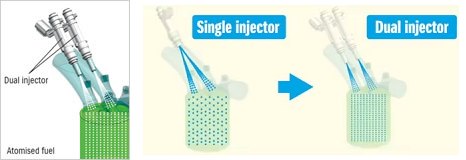 Suzuki's Dualjet system Suzuki's Dualjet systemMore recently, some MPI engines introduced 2 injectors each cylinder, such as Suzuki Dualjet. This allows the injectors to be placed closer to inlet valves, thus the fuel sprays vaporize and fill the cylinder better. As a result, the combustion chamber gets cooler, allowing higher compression ratio to be adopted to enhance output and reduce fuel consumption. Lean Burn engines - the forerunner of direct injection In the late 1980s, Japanese manufacturers headed by Toyota, Nissan and Honda worked hard on Lean Burn technology to improve fuel efficiency. Conventional wisdom says the ideal air-to-fuel mixture ratio for gasoline is 14.6:1 by mass. This ratio is called Stoichiometric ratio. It can be calculated from the chemical reaction formula and molecular masses. In other words, if everything runs ideally, one part of fuel and 14.6 parts of air will combust completely. If extra fuel is applied, it will be only wasted and emitted in the form of pollutants. If less fuel is injected, it will produce less power than the engine capable of. However, when the engine is running at lighter loads, we actually don't need so much power. We can ease the throttle to slow down the engine, but a partially closed throttle butterfly could block the intake air flow and cause "pumping loss" (See explanation in Valvetronic). As a result, the slower the engine runs the more inefficient it becomes. If we could increase the air-fuel ratio beyond 14.6:1, we could use less fuel yet keep the throttle wide open. The problem is, the engine could fail to combust at very lean air-fuel mixture. Lean burn engines avoid this problem by introducing "stratified charge". While conventional engines spray fuel evenly throughout the combustion chambers (i.e. "homogeneous charge"), lean burn engines have their pistons shaped and intake ports situated such that a richer mixture concentrates near the spark plug while leaner mixtures fill elsewhere. In this way, successful ignition is guaranteed even at air-fuel ratio up to 25:1. On the downside, the mixture is so lean that some oxygen molecules have no fuel to react with, thus they react with nitrogen instead and form NOx pollutants. To deal with this, lean burn engines need special NOx-trapped catalytic converters. Today, lean burn technology has evolved into gasoline direct injection thus we no longer hear this term. Gasoline Direct Injection Direct injection has been using on diesel engines for a long time, but getting it work on spark ignition engines was proved to be more difficult. There were many attempts in the past few decades, but the lack of sophisticated electronic control and micro-analysis of combustion process prevented GDI technology from maturing. It only became a mass production reality from the late 1990s. Stratified Charged Direct Injection - Mitsubishi GDI as example 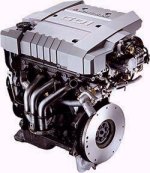 Mitsubishi was the pioneer of modern GDI
technology. It introduced the first GDI engine in 1996, then quickly
expanded the usage to most of its engines, from 1.5-liter four to
4.5-liter V8. According to the company, its GDI technology saved 20-35
percent fuel, generated 10 percent more power but 20 percent less CO2
emission. Mitsubishi was the pioneer of modern GDI
technology. It introduced the first GDI engine in 1996, then quickly
expanded the usage to most of its engines, from 1.5-liter four to
4.5-liter V8. According to the company, its GDI technology saved 20-35
percent fuel, generated 10 percent more power but 20 percent less CO2
emission.Developed from Lean Burn technology, Mitsubishi GDI allowed an ultra-lean air-fuel mixture ratio of up to 40:1. This was made possible by stratified charge as well as high-pressure injectors. In conventional port-injected engines, fuel is injected in the intake port before entering the combustion chambers. Why not inject directly into the cylinder? Because with conventional injectors it is impossible to spread the fuel uniformally everywhere. Instead, injecting at the intake port ensures the fuel has sufficient time to pulverise and mix with air flow. In GDI, fuel is pumped into the combustion chambers at much higher pressure, enabling better pulverisation. Another benefit brought by the high-pressure direct injectors is that injection is carried out faster and far more precisely than the case of port injection. This allows not just one but two injections per combustion cycle. A "pre-injection" takes place before the main injection uses a small amount of fuel spray to cool the air and combustion chambers (which could get very hot during compression), resulting in denser air hence higher volumetric efficiency. Reduced temperature also enhances knock resistance, thus allows a higher, 12.5:1 compression ratio to be adopted. Consequently, the GDI engine could produce more power. 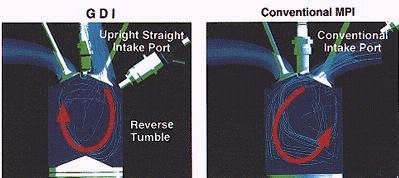 To enable very lean air-fuel mixture
without causing misfire, the GDI used concave-section pistons and very upright,
tumble-generating intake ports. Together, they concentrate a richer
fuel mixture at the region of spark plug, thus successful ignition is
achieved even at very lean mixture (see pictures below).
 The leaner the mixture, the less power it
produces, of course. So how does GDI save fuel? The answer is the same
as Lean Burn engines. GDI operates at stratified charge mode only at
partial load where less power is required. As engine output is now
dependent on the air-fuel ratio, the throttle butterfly can keep wide
opened thus reduces pumping loss. This is mainly how it saves fuel. At
higher or full load, GDI reverts to richer mixture to make more power.
Disadvantages of early GDI
engines
As explained in the section of Lean Burn engines, ultra-lean mixture means some oxygen molecules have no fuel to react with thus they react with nitrogen to form NOx pollutants. To comply with emission regulations, GDI engines need special catalyst to treat NOx. Unfortunately, these catalysts could be damaged by the sulphur content in gasoline. While Japan had been using low-sulphur fuel for a long time, Europe and North America did not until the early and mid-2000s respectively. As a result, Mitsubishi had to tune its European version GDI engines to run richer air-fuel mixture, i.e. 20:1 instead of 40:1, so to produce less NOx. This resulted in lower fuel efficiency. The problem was finally solved when low-sulphur fuel became widely available. The early GDI engines were also criticized for overstated fuel efficiency. In Japan, the government regulated test cycle consisted of mostly low speed operation thus the engine could run in stratified mode for longer time. This explained why Mitsubishi could claim 20-35 percent improvement of fuel efficiency. In Europe, test cycle consisted of far more high-speed run as European motorists drive more on highway. This means the engine worked much less at stratified mode thus fuel economy suffered. Direct Injection by EGR - Renault IDE as example 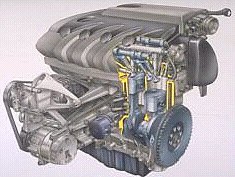 Note:
Renault IDE technology is no longer used by the industry, but it is
still interesting to know how Renault tried to use direct injection
before low-sulphur fuel was available in Europe. Note:
Renault IDE technology is no longer used by the industry, but it is
still interesting to know how Renault tried to use direct injection
before low-sulphur fuel was available in Europe.Renault was the first European manufacturer putting direct injection gasoline engines into production. It launched the 2.0-liter F5R IDE (Injection Direct Essence) engine in 1999. To avoid the troubles encountered by Mitsubishi, it implemented direct injection in a very different way. Instead of pursuing ultra-lean air-fuel mixture, IDE adopted ultra-high Exhaust Gas Recirculation (EGR). By directing some high-pressure, speedy exhaust gas back to the intake manifold, it could accelerate the intake air flow so to reduce pumping loss. Moreover, as exhaust gas is largely non-ignitable and does not take part in combustion, the effective engine capacity is actually reduced, requiring less fuel to be injected. At light load, the IDE engine allowed as much as 25% EGR compared with 10-15% on cars with conventional EGR. How could IDE engine run at 25% EGR without failing to combust? Thanks must go to the direct fuel injector located at the center top of each combustion chamber in place of spark plug. The latter was relocated to the side nearby, very close to the injector nozzle. The Siemens injector injected high pressure fuel (at 100 bar or 1450 psi) directly into the combustion chamber. As the inclined spark plug located just at the path of the fuel spray, successful combustion was guaranteed even with 25% exhaust gas present in the chamber. Depending on engine load, IDE ran at one of the 3 available EGR ratios, among them the full load mode used no exhaust gas recirculation for the need of maximum power. Therefore, like Mitsubishi GDI, running at full load saved no fuel. However, overall speaking Renault claimed 16% reduction of fuel comsumption according to the European test cycle. It also improved power a little bit. The 1998 c.c. engine produced a solid 140 hp and 148 lbft of torque. For comparison, the non-IDE but variable valve timing-equipped version managed the same 140 hp but merely 139 lbft of torque. The gain of output was down to a higher, 11.5:1 compression ratio. Like Mitsubishi GDI, a pre-injection in prior to the main injection helped cooling the combustion chambers, raising knock resistance thus enabled a higher compression ratio. Stoichiometric Direct Injection - Alfa Romeo JTS as example 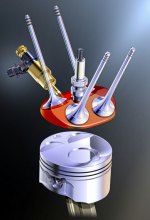 In 2002, Alfa Romeo introduced a new direct injection
system on its 2.0-liter 16V engine. Called JTS (Jet Thrust
Stoichiometric), it biased towards power instead of fuel economy,
unlike the contemporary Mitsubishi GDI. Compared with the 2.0
Twin-spark engine on which it was based, the JTS engine produced
considerably more power (165 hp vs 150 hp) and torque (152 lbft vs 133
lbft). In the following decade, JTS was used in the company's 1.9 and
2.2-liter four cylinder as well as 3.2-liter V6. In 2002, Alfa Romeo introduced a new direct injection
system on its 2.0-liter 16V engine. Called JTS (Jet Thrust
Stoichiometric), it biased towards power instead of fuel economy,
unlike the contemporary Mitsubishi GDI. Compared with the 2.0
Twin-spark engine on which it was based, the JTS engine produced
considerably more power (165 hp vs 150 hp) and torque (152 lbft vs 133
lbft). In the following decade, JTS was used in the company's 1.9 and
2.2-liter four cylinder as well as 3.2-liter V6.As implied by its name, the JTS normally worked with air-fuel mixture close to Stoichiometric ratio (14.6:1), just like conventional engines. It did have a lean burn mode, but that was used only up to 1500 rpm, so the gain of fuel efficiency was modest. Because of this, its combustion chamber design did not need to be optimized for stratified charge, thus it could employ cross-flow cylinder head and flat pistons commonly found on high-performance engines. In contrast, Mitsubishi GDI needed to employ upright intake ports and concave pistons, both worked against the speed of breathing. What helped the JTS engine to make more power than Twin-spark engine was a higher compression ratio (11.3:1 vs 10.0:1). This was made possible by the cooling effect of spraying the fuel directly into combustion chambers. The cooling effect also made the air denser thus explained the increased torque. Spray-guided Direct Injection - Mercedes CGI as example In 2006, Mercedes introduced a new kind of gasoline direct injection technology on its CLS350 CGI, where CGI stands for Stratified-Charged Gasoline Injection. In order to distinguish from existing GDI technology, it should be referred to "spray-guided direct injection". What does this mean? Let's recall how Mitsubishi GDI worked - its fuel spray was guided by intake air flow and piston to concentrate at the neighbourhood of spark plug, so engineers call it air-and-wall-guided GDI. Volkswagen's FSI and most other car maker's GDI systems work in more or less the same way. In contrast, Mercedes CGI does not need air flow or piston to guide the fuel spray. The spray is actually shaped by the piezo injector. As seen in the picture below, a centrally mounted piezo injector is capable to produce a hollow cone of fuel spray. This fuel cloud remains stable up until the moment of ignition. It is so precise that the spray is only millimeters away from the spark plug, thus successful ignition is easily achieved. 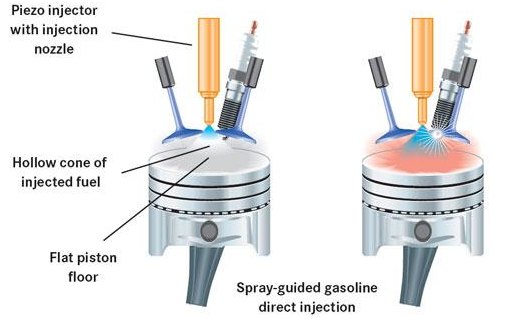
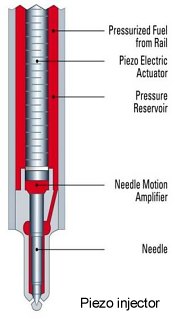 Apparently, piezo injector is a key part of the technology. It is not exactly new though, as it has been widely used on high-end diesel engines. It uses piezoelectric crystals, which expand immediately under electrical voltage, to move the nozzle valve outward, so that the high-pressure (200 bar) fuel supplied by steel rail is released from the ring-shaped opening to form a hollow cone of fuel spray. Compared with conventional solenoid valve injectors, piezo injectors are far more responsive, taking as little as 0.08 millisecond to finish an injection. It is also capable of finely control the amount of fuel, ranging from 1 to 150 mg per shot. Therefore, it allows more injections during each combustion cycle (up to 8 times at the moment) and more precise control of fuel spray. Then what are the benefits? Firstly, the combination of more injection shots and less fuel each shot improves pulverisation and formation of mixture. Secondly, as the fuel no longer splashes onto the piston and cylinder wall, there is less residual left at the piston and wall surfaces. In other words, more complete combustion. Thirdly, for the same reason, less pollutants, especially particulates, are formed at the piston and cylinder wall. This makes spray-guided direct injection easier to comply with EU6 regulation without resorting to particulate filters or other aftertreatments. Compared with other GDI systems, CGI is capable to use stratified charge across a wider rev range thus saves more fuel. For example, the 3.5-liter CGI V6 operated in stratified mode up to 3800 rpm, while the newer M274 2.0-liter turbo works until 4000 rpm, covering 80 percent of the European test cycle. To extend efficiency further, in the next 200 rpm they switch to homogeneous-stratified mode, which applies a main injection during intake stroke (homogeneous charge) and multiple small injections (stratified charge) during the compression stroke. At higher rpm, homogeneous charge mode takes over. Spray-guided direct injection is still a rarity on the market because piezo injectors are expensive, i.e. 3 times the price of conventional solenoid injectors. BMW used it on its N54 3-liter twin-turbo straight-6 from 2007 to 2011, but eventually reverted to solenoid injectors in the next generation N55 to save cost. Today, Mercedes remains to be the keenest supporter of the technology. Dual-mode Injection (Direct + Port) - Toyota D-4S as example 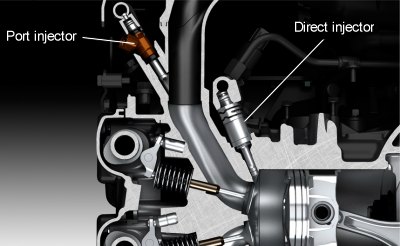 Direct injection is superior to port injection in many
aspects, but under some conditions port injection might work better.
Therefore some manufacturers opt to equip both on their engines.
Toyota's D-4S (Direct injection, 4-stroke, Superior) was the first one.
It was introduced in 2005 on the company's 3.5-liter V6 (2GR-FSE) that
served Crown, IS350 and GS350. The one pictured is the version on the
FA20 engine of GT86. Direct injection is superior to port injection in many
aspects, but under some conditions port injection might work better.
Therefore some manufacturers opt to equip both on their engines.
Toyota's D-4S (Direct injection, 4-stroke, Superior) was the first one.
It was introduced in 2005 on the company's 3.5-liter V6 (2GR-FSE) that
served Crown, IS350 and GS350. The one pictured is the version on the
FA20 engine of GT86.One circumstance DI doesn't work so well is the combination of low rev and high load, for example, accelerating from low speed. To generate more power the engine has to switch to homogeneous charge mode, i.e. with rich and uniformal air-fuel mixture. As fuel is injected directly into the cylinder, there is little time for it to vaporize. At low rpm where intake air flow is slow, the problem gets worse, thus the charge is partially homogeneous and partially stratified. This leads to unstable combustion and torque fluctuation. Traditionally, the problem can be dealt with generating strong tumble or swirl in the air flow by means of tumble intake port or swirl control valve. However, this restricts breathing thus hurt high-end power. 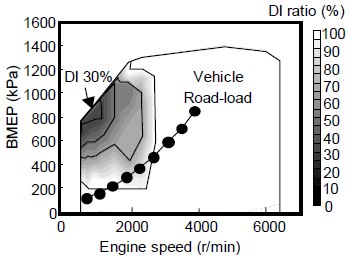 Therefore, Toyota
decided to add port injection. This graph shows how much port injection
is used on the 2GR-FSE V6. The Y-axis is Brake Mean Effective Pressure,
which is proportional to torque output thus you can understand it as
engine load. At low engine speed and high load, 70 percent of fuel is
injected by port injection, while 30 percent comes from direct
injection. As rev rises or load reduces, direct injection takes over.
Beyond 2600 rpm, the engine is fed by direct injection only. Therefore, Toyota
decided to add port injection. This graph shows how much port injection
is used on the 2GR-FSE V6. The Y-axis is Brake Mean Effective Pressure,
which is proportional to torque output thus you can understand it as
engine load. At low engine speed and high load, 70 percent of fuel is
injected by port injection, while 30 percent comes from direct
injection. As rev rises or load reduces, direct injection takes over.
Beyond 2600 rpm, the engine is fed by direct injection only.Thanks to the port injection, the 3.5-liter V6 could adopt a high-flow intake port to benefit power. This explains why it could produce as much as 315 hp. More recently, Volkswagen group also added port injection to its high-end EA888 engines. However, the purpose here is to cut emissions. The inhomogeneous mixture of GDI at low speed and wetting of piston and cylinder wall by direct fuel spray tend to form more particulates. Volkswagen avoids this by using port injection at part-load operation. It adds cost, of course, but the high-end versions of EA888 engine need it to avoid compromising power tuning. Diesel: Common-rail Direct Injection Diesel has long been the favourite fuel for commercial vehicles thanks to its lower prices (especially in Europe) and higher energy efficiency compared with petrol, also due to the higher reliability of diesel engines as there is no ignition system. It was not as popular in passenger cars though, because diesel engines are less powerful, noisier and more polluting. However, as technology improved, diesel cars became more and more popular since the late 1980s. The lack of power was addressed by turbocharing, which worked especially well on diesel engines. An older version of this article compared an Audi A3 1.8 petrol and 1.9 TDI of the late 1990s and found the TDI offered better real-world performance yet beat its petrol sister convincingly in fuel economy, i.e. 54 vs 36 mpg. Regarding noise and emission, modern fuel injection helped a lot. Fiat Croma introduced the first direct injection in 1987. The Italian company continued to lead diesel technology by developing the first common-rail direct injection, Unijet. Although the project was sold to Bosch later, Alfa Romeo 156 was the first application of common-rail direct injection in 1997. 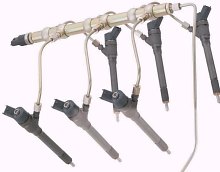 How did diesel engines get both direct
injection and common-rail technology much earlier than petrol engines?
Compared with petrol, diesel is the lower quality ingredient of
petroleum family. Diesel molecules are larger and heavier than petrol, thus
are more difficult to pulverise. Imperfect pulversation could lead to
more unburnt particulates, hence more pollution, lower fuel efficiency
and less power. Common-rail technology was designed to address these
problems. To improve pulverisation, the fuel should be injected at a
very high pressure, so high that conventional fuel injectors could not
achieve. In a common-rail system, the fuel pressure is implemented by a
powerful pump instead of fuel injectors. The high-pressure fuel is fed
to individual fuel injectors via a common rigid pipe (hence the name of
"common-rail"). In the first generation Bosch system, the pipe
withstood a pressure as high as 1350 bar. This was lifted further to
1600 bar in 2nd generation, 1800 bar in 3rd generation and up to 2500
bar presently. The fuel always remains under such pressure even in
stand-by state. Therefore, as soon as the injector nozzle opens, the
fuel is injected into the combustion chamber immediately. As a result,
not only pulverisation is improved by the higher fuel pressure, but the
duration of fuel injection can be shortened and the timing can be
precisely controlled. To improve response further, piezo injectors (see
Spray-guided direct injection) were introduced
from 2005 as an alternative to solenoid injectors. How did diesel engines get both direct
injection and common-rail technology much earlier than petrol engines?
Compared with petrol, diesel is the lower quality ingredient of
petroleum family. Diesel molecules are larger and heavier than petrol, thus
are more difficult to pulverise. Imperfect pulversation could lead to
more unburnt particulates, hence more pollution, lower fuel efficiency
and less power. Common-rail technology was designed to address these
problems. To improve pulverisation, the fuel should be injected at a
very high pressure, so high that conventional fuel injectors could not
achieve. In a common-rail system, the fuel pressure is implemented by a
powerful pump instead of fuel injectors. The high-pressure fuel is fed
to individual fuel injectors via a common rigid pipe (hence the name of
"common-rail"). In the first generation Bosch system, the pipe
withstood a pressure as high as 1350 bar. This was lifted further to
1600 bar in 2nd generation, 1800 bar in 3rd generation and up to 2500
bar presently. The fuel always remains under such pressure even in
stand-by state. Therefore, as soon as the injector nozzle opens, the
fuel is injected into the combustion chamber immediately. As a result,
not only pulverisation is improved by the higher fuel pressure, but the
duration of fuel injection can be shortened and the timing can be
precisely controlled. To improve response further, piezo injectors (see
Spray-guided direct injection) were introduced
from 2005 as an alternative to solenoid injectors.Benefited by the short duration and precise timing, common-rail injection system is able to introduce multiple "pilot injections" before the main injection during the compression phase to suppress noise, greatly improving refinement. It may also introduce "post-combustion", which injects small amount of fuel during the expansion phase to create a small-scale combustion. This further eliminates the unburnt particles, also increases the exhaust gas temperature thus shortens the time taken to bring catalytic converters into operating temperature. In short, "post-combustion" cuts pollutants, especially during cold start. Competing with common-rail direct injection in the 2000s was Volkswagen's pump injection ("Pumpe Duse"). It used a camshaft-driven, pump-incorprated injector at each cylinder to produce a pressure comparable to common-rail systems. However, as it could not suppress noise as good as common-rail, VW eventually abandoned it and turned to the common-rail camp. Today, CDI becomes standard on virtually all diesel cars. Water Injection Water injection is a technology to increase output of turbocharged engines. Since turbocharged engines are hot, by injecting a fine spray of water into the intake manifold can reduce the temperature of combustion chambers, improving knock resistance. This means the engine can use higher boost pressure without worrying about knock. Moreover, the water spray cools also the intake air, making the latter denser, improving volumetric efficiency thus producing more power. Besides, the lower combustion temperature reduces the formation of NOx and CO. Water injection was originally developed for aircraft engines, no wonder Saab was the first to apply it to road cars. The Swedish car maker offered it on 99 Turbo from 1978, allowing the car to lift turbo boost pressure from 0.7 to 1.2 bar and improving output from 145 to 160 hp. It was also offered as tuning kits on the succeeding 900 Turbo until the late 1980s. Strangely, no other car makers followed suit, perhaps because modern intercoolers do the cooling job so well. 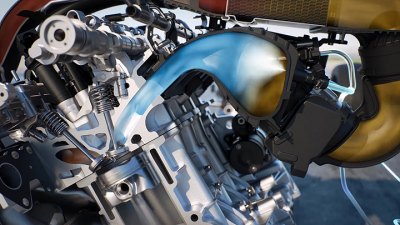 Water injection on BMW M4 GTS However, in 2016 BMW resurrected the idea on M4 GTS. A 5-liter water tank at the boot supplies water to the 3 injectors located in the intake manifold. They inject the water spray at 10 bar. The water evaporates, cools the intake air from 70 to 45°C. This allows the turbo boost pressure to be lifted from 1.3 bar on the regular M4 to 1.5 bar. For extreme performance cars like the M4 GTS, water injection will be very useful. |
||
| Copyright© 1997-2017 by Mark Wan @ AutoZine |